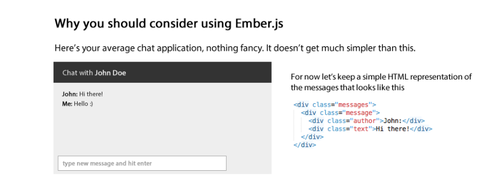A promise ate my homework (or exception) Written by Jakub Arnold, Jun 10, 2013
If you’ve ever used a library based on promises such as Ember.js/Ember Data you’ve probably stumbled upon this. Or maybe you haven’t, but the app was silently failing with no error message, which is even worse.
The reason for this is simple and it is actually an intentional feature...
How to write a login form that doesn't suck, using Ember.js Written by Jakub Arnold, May 23, 2013
When using frameworks such as Ember.js, we often find ourselves forgetting the main reason why we chose to use the framework. We don’t do it because it’s cool, or at least we shouldn’t. We don’t do it because somone told us we have to use Ember (unless your boss doesn’t have much brains). We do it because want to make the user experience better. I won’t go into details about server side implementation, this is purely about UX.
Why you should consider using Ember.js Written by Jakub Arnold, May 14, 2013

View the entire content here
Mac OS X: Emacs-like keybindings everywhere Written by Jakub Arnold, Oct 19, 2012
One of the reasons why I love working with OS X is the Emacs-like keybindings, which are available in the whole system. One of the most used ones for me are Ctrl-a and Ctrl-e for jumping to the start and the end of a line.
But sometimes you need more than that, for example forward...
Pathogenize your VIM Written by Jakub Arnold, Oct 18, 2012
We’re going to take a look how to create your own .vim config in a matter of minutes. There are many ways to do this. First one is pathogen, which I’m going to describe in this article, and then there’s also janus and vundle.
I prefer pathogen because it’s dead simple, you just...
Gem developers: Let the user choose the JavaScript engine Written by Jiri Pospisil, Oct 10, 2012
As gem developers, we sometimes need to make a decision about what JavaScript engine to use together with our code or assets. This decision usually means adding a dependency on other gem that provides such an engine.
There are choices depending on your platform, such as therubyracer
GIT: To force-push or not to force-push Written by Jan Votava, Oct 9, 2012
Be aware that force-pushing is a highly dangerous and unclean solution when you’re working in a shared repository. All commits in the shared repository should be considered immutable. To keep your repository consistent and keep your coworkers happy, you should use git revert instead...
Who we are
This is the blog of sensible.io, a web consultancy company providing expertise in Ruby and Javascript.
Recent articles
- SSH Tunnel - Local and Remote Port Forwarding Explained With Examples
- Supercharge your VIM into IDE with CTags
- Don't just dump code into your models
- Getting started with Ember App Kit
- 4 Tips for Working with Dates in PostgreSQL
- PostgreSQL Sequences and Array Column Types
- Setting up Redis for Production Environment
- PostgreSQL Basics by Example
- Strong Parameters by Example
- Ember Model - Introduction
Tags
- rails (1)
- ruby (3)
- osx (1)
- vim (1)
- ember (3)
- ember-model (1)
- postgresql (3)
- ruby vim ctags (1)
- unix (1)
- redis (1)
- promises (1)



